Ben was the primary motivator for the visit. When we went there 3 years ago he refused to ride in the canoe because he was afraid of falling out. I spent the entire time walking the trail with him while Shira went canoeing with my cousin, Janene, and the other homeschoolers. He figured that he would enjoy canoeing now as he has enough balance skills and has lost his fear of water
Last year Ben became proficient in the water and a few weeks ago he finally agreed to learn to ride his bike without training wheels. Now he can't understand why he was so scared of falling off his bike for so long. I almost wish he'd stayed scared because he is a holy terror on both his bike and scooter. Every day sees him trying a new trick. Yesterday he was scooting while pretending to be a cossack dancer. I've had to convince the kids that riding their bikes with no hands and eyes closed is a recipe for disaster, and is not a fancy trick.
Anyway, Ben no longer fears swings, bikes, canoes or anything that challenges his vestibular system, so it was off to Merchant's Millpond for a guided canoeing trip by Ranger Jane.
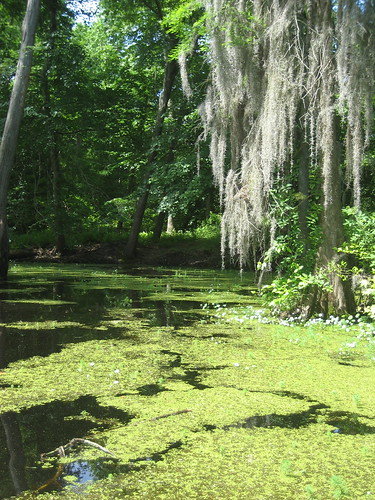
The 760-acre millpond is more than 190 years old and has developed into complex, mature ecosystems. Towering bald cypress and tupelo gum trees, displaying growths of Spanish moss and resurrection ferns, shade the pond's dark, acidic waters. Numerous species of aquatic plants, such as the floating yellow cow lily and the submerged coontail, thrive in the pond. A red and green layer of floating duckweeds and water fern often covers the water's surface. Moved about by wind and current, these floating mats create a changing mosaic of colors and patterns
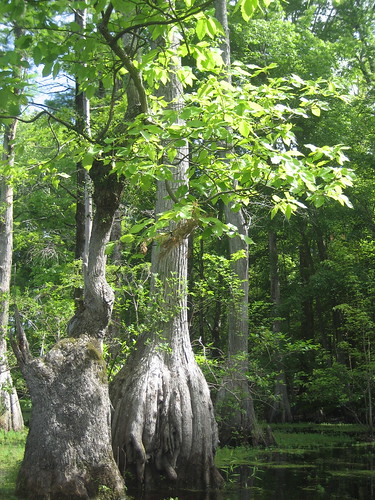
Tupelo Gum
At the upper end of the millpond is Lassiter Swamp, an ecological wonderland containing remnants of an ancient bald cypress swamp — an eerie "enchanted forest" worthy of a fairy tale. Mistletoe has twisted and gnarled the trunks and branches of tupelo gum into fantastic shapes. Surrounding the aquatic communities is an unspoiled wilderness. Stands of American beech highlight a mixture of pine and hardwood forests.
The diverse habitats in the park support a variety of animals. Wetland wildlife is particularly abundant. Frogs thrive in the aquatic environment of the millpond, and spring and summer rains bring a mixed chorus of carpenter frogs, leopard frogs, bull frogs, cricket frogs and species of tree frogs. Several species of pond turtles, often called cooters or sliders, bask on warm logs and stumps while the snapping turtle makes easy prey of other aquatic creatures. Water snakes are plentiful. Most of them are harmless, but the venomous cottonmouth is also present. Treat any encounter with a snake with caution and respect.
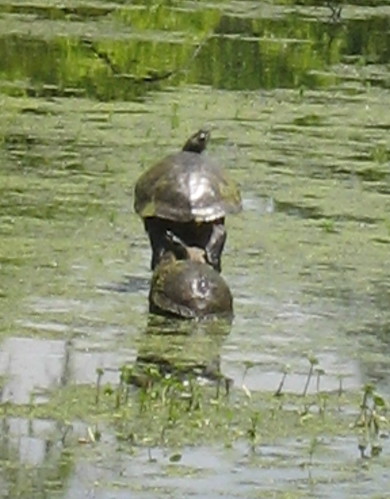
Cooters
In addition to game fish, two primitive species of fish — the long-nosed gar and the bowfin — inhabit the millpond. These interesting species have remained relatively unchanged for millions of years. Both the gar and the bowfin are large and important predators in the blackwater habitats of the coastal plain.
More than 200 species of birds, ranging from graceful egrets to turkeys and owls, have been recorded in the park. Spring and fall bring migrations of swamp warblers, parulas, prothonotaries and yellow-throated warblers. In winter, a variety of waterfowl stop by on their journey south. Lucky visitors may catch a glimpse of the beautiful hooded merganser, a small fish-eating duck whose males flaunt a magnificent black-bordered white crest. Pileated woodpeckers, barred owls, and red-shouldered hawks also enjoy the swamplands.
Paddling on the pond or creek is a great way to see several species of interesting mammals. Though beavers themselves are rarely encountered, dams, lodges, and teeth marks attest to their presence. Mink, river otter and bobcat are occasionally spotted. Deer, raccoons and opossums are also in residence. Bats roost in clumps of Spanish moss and are often visible at dusk when they dip to the surface of the pond to drink.
Our group getting ready to go out with Ranger Jane
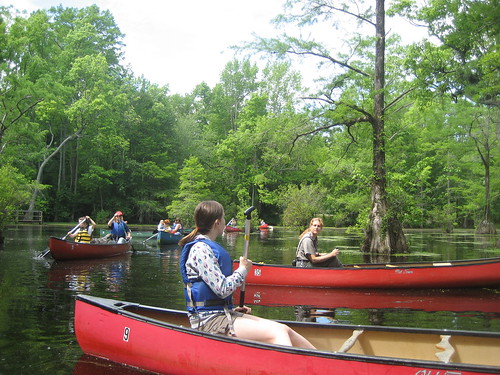
I found that paddling with Ben was an interesting experience to say the least. Try as Shira and I might, we just couldn't get him to understand that paddling is a group effort and that he couldn't do things his way and not take head of what the other two people in the boat were doing. As luck would have it, Ben is hooked on canoeing and now wants to go kayaking closer to home. I need to find out if kids his age can go out in single kayaks. I'd love to go kayaking with the kids, but with each of us in our own kayaks.
After the guided trip was over, we had a picnic, then explored the park on our own.
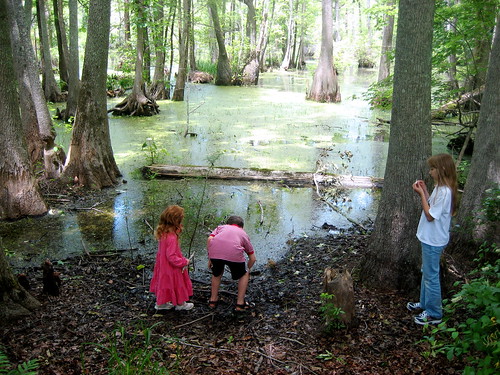
Here are Ben and looking at interesting things
This was a great field trip and I highly recommend it to other area homeschoolers. We're planning on making this an annual event.













2 comments:
Beautiful!
Does Ben have any bicycling tips for Rhiannon? She got a new bike for her birthday because she outgrew her first one. And she still needs training wheels. She was getting very frustrated because she expects to be proficient immediately and gives up too easily.
About a year ago Marc read that you need to teach bicycling in two steps. The first is to teach balance and that is best taught on a scooter, not a bike. Only once the child is comfortable balancing, should you attempt to teach them to co-ordinate balancing with pedaling and steering.
We bought them Razor scooters a year ago and spent lots of time on them. When we saw they were balancing well we suggested they try their bikes. Both refused for six months. Then when I decided I wanted a trike I told them that I was not taking them for rides while they had training wheels.
That afternoon they learned to ride their bikes. it took Shira around 10 min and Ben about 20. He got the balance part quickly but couldn't start on his own.
Post a Comment